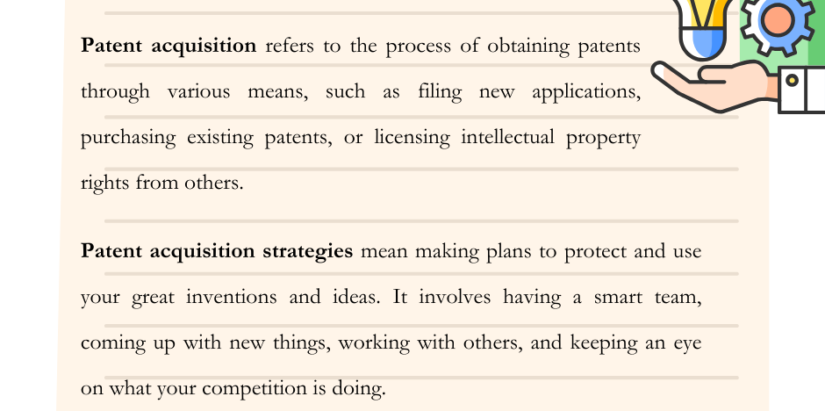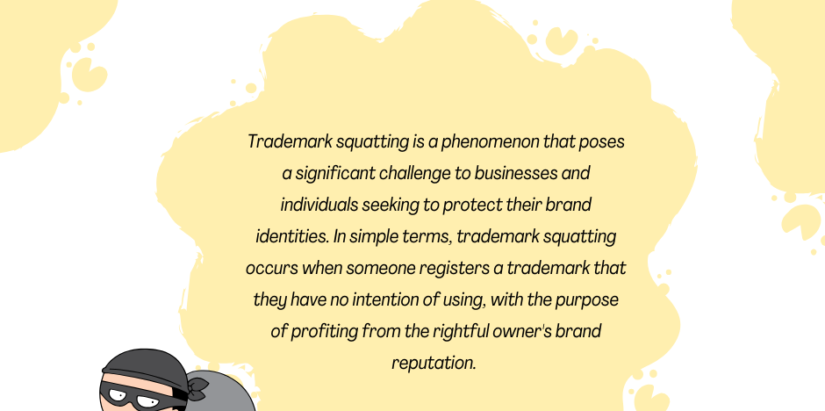Introduction
In the rapidly evolving landscape of innovation, safeguarding intellectual property rights has become indispensable for companies striving to maintain a competitive edge. Patent acquisition, the method of acquiring exclusive rights to an invention, is a crucial element in safeguarding a company’s inventive creations and promoting sustained development. This comprehensive guide delves into the importance of patent acquisition and outlines strategies to navigate the intricate terrain of securing these rights.
What is Patent Acquisition?
Patent acquisition refers to the process of obtaining patents through various means, such as filing new applications, purchasing existing patents, or licensing intellectual property rights from others. Patents grant inventors exclusive rights to their inventions, providing a legal framework to protect their innovations from being exploited by others.
Importance of Patent Acquisition
Patent acquisition is a critical aspect for businesses, serving as a powerful safeguard for their inventive ideas. Exclusive rights granted by patents act like a protective barrier, preventing competitors from copying or profiting from those groundbreaking concepts. This exclusivity also translates into a substantial advantage in the market, allowing companies to dominate their industry and set premium prices for their offerings. Beyond the protective function, patents create opportunities for additional income through licensing arrangements.
Companies can license their patented ideas to others, generating extra revenue streams. Moreover, having a robust portfolio of patents enhances a company’s attractiveness to investors and potential partners. It signals a commitment to innovation, solidifying the company’s perceived value in the eyes of the business community. In essence, patent acquisition is not just about protecting ideas; it’s a strategic necessity for companies aiming to secure their innovations, lead in the market, and achieve long-term growth and financial success.
Patent Acquisition Strategies
Patent acquisition strategies mean making plans to protect and use your great inventions and ideas. It involves having a smart team, coming up with new things, working with others, and keeping an eye on what your competition is doing. The goal is to keep your ideas safe, be better than others, and find ways to make money from your inventions. Some patent acquisitions strategies that can be followed by the inventors or companies are explained below:
Build a Strong Internal Team:
In-House Expertise:
Cultivating a team of experts within the organization involves hiring or training individuals who possess a deep understanding of the industry, technology landscape, and the legal intricacies associated with patent acquisition. This may include professionals with technical backgrounds who can assess the patentability of innovations, as well as legal experts who can navigate the complex world of intellectual property law.
Cross-Functional Collaboration:
Fostering collaboration between Research and Development (R&D), legal, and business development teams is crucial for a holistic approach to patent acquisition. R&D teams need to work closely with legal experts to ensure that innovations are identified and protected in a way that aligns with legal requirements. Business development teams can help identify strategic opportunities for acquiring or licensing patents that align with the company’s overall goals.
Strategic Research and Development:
Proactive Innovation:
Encouraging a culture of proactive innovation means motivating R&D teams to consistently explore new ideas and technologies. This proactive approach helps identify potentially patentable inventions before competitors, giving the organization a competitive edge.
Freedom-to-Operate Analysis:
Conducting freedom-to-operate analyses involves thoroughly researching existing patents to ensure that the company’s innovations do not infringe on the intellectual property rights of others. This analysis helps identify potential patent barriers and allows the organization to design workarounds or take appropriate licensing measures to avoid legal issues.
Collaborate and License:
Strategic Partnerships:
Collaborating with other organizations through partnerships and joint ventures can be a mutually beneficial strategy. Shared resources and cross-licensing opportunities can provide access to new technologies, expand the patent portfolio, and create synergies that drive innovation.
Licensing Agreements:
Licensing agreements involve either acquiring or providing access to patented technologies. This strategy allows organizations to monetize their own patents by licensing them to others or gain access to external innovations that complement their product or service offerings.
Monitor Competitor Activity:
Competitive Intelligence:
Staying vigilant and monitoring competitors’ patent activities is crucial for understanding the landscape and identifying potential threats or opportunities. This involves regular analysis of competitors’ patent portfolios, tracking new filings, and assessing the strategic direction of rival organizations.
Patent Infringement Detection:
Implementing robust systems for detecting potential patent infringements is essential. This involves using technology and legal expertise to monitor the market and identify instances where competitors or other entities may be using patented technologies without authorization. Timely detection allows for legal action, such as sending cease-and-desist letters or filing infringement lawsuits.
Xiaomi’s Patent Acquisition Journey
Xiaomi, a big Chinese tech company, had some legal issues when they were growing globally. They got sued by a company called Blue Spike in the US over a technology patent related to data protection. This and similar lawsuits underscored the significance of intellectual property (IP) for Xiaomi, prompting the company to reevaluate its approach.
In response, Xiaomi shifted its strategy by actively pursuing patent acquisition to fortify its IP portfolio. Instead of merely relying on organic patent filings, the company engaged in licensing agreements and acquisitions, rapidly increasing its patent count from 35 in 2011 to over 8,600. This strategic move aimed to mitigate legal risks and strengthen Xiaomi’s position in international markets.
The transformative impact of this patent acquisition strategy became evident as Xiaomi successfully navigated challenges, such as the injunction in India. Getting thousands of patents made Xiaomi strong and adaptable in the changing global market.
The company’s success demonstrates the potential for strategic patent acquisition to enhance business resilience and facilitate smooth expansion into new markets.
Conclusion
In the dynamic landscape of intellectual property, patent acquisition is a multifaceted strategy that goes beyond mere legal protection. It is a cornerstone for companies seeking to innovate, protect, and thrive in competitive markets. By understanding the importance of patent acquisition and implementing effective strategies, organizations can secure their position as industry leaders, much like Xiaomi in the global tech arena.



